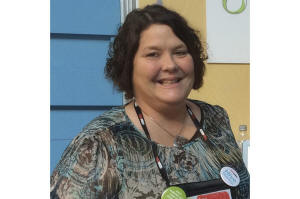Meet Amy Gleason, the DOGE administrator who may — or may not — be
wielding extraordinary power
[March 08, 2025]
By RYAN J. FOLEY and BRIAN SLODYSKO
When her daughter was diagnosed with a rare autoimmune disease in 2010,
Amy Gleason attacked the challenge.
She carried binders of medical records to doctors’ appointments across
six health systems seeking the best care for juvenile dermatomyositis.
She volunteered at a nonprofit searching for a cure. She also started a
health care company to create record-sharing software that would make
life easier for chronically ill patients and families.
Within five years, President Barack Obama’s White House recognized
Gleason as a “Champion of Change” in the industry. When the coronavirus
struck in 2020, she was a health care technologist in the first Trump
White House who worked grueling hours building data systems to guide the
federal response. (And her daughter was a thriving college student.)
Now, her journey has improbably led to President Donald Trump naming her
the acting administrator of the U.S. DOGE Service, a position that seems
to convey extraordinary power. Except almost no one has heard of her and
everyone knows the man the president says is actually leading the
unparalleled effort to gut the federal workforce and shutter agencies:
Elon Musk.
Gleason's role at DOGE is unclear
While Musk has claimed his Department of Government Efficiency is fully
transparent, until last week the White House press secretary would not
even say Gleason's name — which does not appear on the DOGE website.
In his address to Congress Tuesday, Trump made clear that Musk is in
charge, saluting him as the head of DOGE, with Musk smiling down on the
president from the visitors' gallery. Yet government lawyers have argued
in court that Gleason and not Musk is the agency’s leader.
The confusion has added to the mystery around the role of Gleason, who
did not respond to a phone call or text message for comment.
“I don’t think anyone really knows for sure what her role is and whether
she actually has any oversight of any of the people doing the work, or
is she just there as a punching bag and a distraction to keep their
actual activities shielded from the public,” said Brett Hartl,
government affairs director for the Center for Biological Diversity, an
environmental group that sued the DOGE Service and Gleason seeking
access to records that would shed light on their operations.
DOGE claims credit for saving more than $100 billion through mass
firings, cancellations of contracts and grants, office closures and
other cuts that have paralyzed entire agencies. Many of those claimed
savings have turned out to be overstated or unproven.
Gleason is known as a behind-the-scenes operator
On one level, Gleason fits the mold of a Musk employee, one willing to
work arduous hours to meet his goals. Former colleagues say she is an
effective behind-the-scenes operator and say her rise is the story of a
former nurse who got into health care technology to help patients and
doctors and climbed through merit.
“From my perspective, I can’t imagine somebody I’d rather have there,”
said Jamie Grant, a former Republican lawmaker in Florida who worked
with Gleason to start a health care company. “Somebody saying yes to
that job right now better believe in the mission and better have a spine
and be talented and she’s that in spades.”

White House press secretary Karoline Leavitt told reporters that Gleason
had served as the acting administrator at DOGE for weeks. But that was
not the widely held understanding of her position internally, according
to three people with knowledge of the office’s operation who spoke on
condition of anonymity out of fear of retribution.
While the exact nature of Gleason’s portfolio was not well defined, what
was clear is that she was working closely with DOGE leaders. She
attempted to push civil service staffers in the office to hire at least
two people who failed screening reviews for prospective hires; both were
later hired by DOGE, according to two of the people who spoke to The
Associated Press.
The uncertainty over her role — and when she was appointed to it — could
have far-reaching implications in a series of ongoing lawsuits filed to
blunt the impact of Musk's radical paring of the government workforce.

[to top of second column]
|

This image provided by Travis Bond shows Amy Gleason, the acting
administrator of the DOGE Service, pictured in 2014 at a health care
technology conference in San Francisco, (Travis Bond via AP)

Under questioning from U.S. District Court Judge Colleen
Kollar-Kotelly recently, government attorneys struggled to explain
who was in charge of DOGE or Musk's precise role. That led
Kollar-Kotelly to wonder if the office was running afoul of the
Constitution’s appointments clause because Musk had not been
nominated to lead the office, or received confirmation from the
Senate.
The Trump administration announced the following day that Gleason
was DOGE's acting administrator, a question they had previously
refused to answer.
Gleason has ties to Trump world
Unlike many DOGE workers, Gleason has no prior ties to Musk. She
recently worked as chief products officer at Nashville-based health
care firms founded by Brad Smith, who worked in the prior Trump
administration on health care and is also a DOGE adviser.
Smith and Gleason began working on Trump’s transition after the
November election, and her role in Trump's orbit has grown. In
December, she rejoined the United States Digital Service, where she
had previously worked from 2018 through 2021 on high-level
government health care technology initiatives.
On his first day back in office, Trump signed an executive order
rebranding USDS as the US DOGE Service and giving it a mandate to
help Musk’s cost-cutting initiative. Soon, dozens of Musk acolytes
associated with DOGE began arriving at agencies across the
government demanding access to sensitive data systems and pushing
for drastic changes.
While 21 others in the office resigned in protest rather than carry
out Musk’s initiatives, Gleason accepted a position that thrust her
into an unfamiliar spotlight.
Health care entrepreneur Travis Bond, Gleason’s colleague over two
decades at companies in Florida, said Gleason will hate the public
attention but excel in her new role.
“I’m not sure they could have picked a better person. She just
thinks, eats and breathes this stuff,” he said.
Gleason helped build CareSync, which later collapsed
Bond, Gleason and Grant in 2011 launched CareSync Inc., which
developed an app to allow patients suffering from chronic disease to
keep their medical records in one place. After benefiting from a
$7.25 million grant from one Florida county, CareSync found it hard
to attract buyers for subscriptions that cost up to $199 annually.
CareSync pivoted in 2015, taking advantage of a new federal rule
that allowed Medicare providers to bill for chronic care management
services delivered remotely. The company raised millions of dollars
from investors and began rapidly adding staff and serving more than
20,000 patients nationwide. By summer 2018, CareSync ran out of cash
and closed without notice, firing 300 workers and leaving creditors
owed millions.
Gleason recalled later that she was “trying to figure out what in
the world to do in life” after that experience and applied for the
USDS with encouragement from Aneesh Chopra, U.S. chief technology
officer under Obama. Chopra declined comment.
She focused on improving technology systems at the Centers for
Disease Control and Prevention and the Centers for Medicare and
Medicaid Services. During the pandemic, she worked under White House
response coordinator Dr. Deborah Birx to develop laboratory and
hospital data reporting systems. Birx praised Gleason last week in
an interview with CNN as a “really competent, hardworking, focused
woman who understands the value of data.”
Near the end of her three-year stint in 2021, Gleason reflected on
her work in a podcast interview, saying the digital service sought
to “empower the civil servants and to bring new approaches in
technology to the government and to help modernize their efforts.”
“Our mission is really to do the greatest good, for the greatest
number of people, in the greatest need,” she said.
All contents © copyright 2025 Associated Press. All rights reserved |